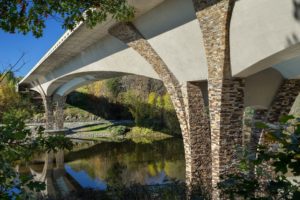
Beton’s Kevin MacDonald designed the concrete mixture proportions and performed thermal control modeling for the I-91 Brattleboro Bridge in Vermont. The bridge took First Place in the Infrastructure Division of the 2019 ACI (American Concrete Institute) Excellence in Concrete Construction Awards program.
This is Vermont’s first concrete segmental bridge, with a design service life of 150 years. To achieve that kind of durability, Dr. MacDonald designed a ternary concrete mixture with slag cement, portland cement, and silica fume.
“This project did a great job in maximizing concrete’s ability to compliment the natural environment, to allow for innovative construction methods based on project needs, and to provide a durable, long-lasting solution.” —Christopher Westbrook, awards judge
The bridge used a total of 18,882 yd3 of concrete. In order to accommodate the heavy reinforcement and the curvature of the piers, Dr. MacDonald designed a self-consolidating concrete. The concrete piers and columns were made to look like natural stone so they fit in with the surroundings.
Although the footings required a 700-yd3 mass concrete placement–the largest ever in Vermont–Dr. MacDonald was able to avoid using cooling tubes. Cooling tubes, while effective in controlling internal temperatures, add considerably to the complexity and cost of construction.
